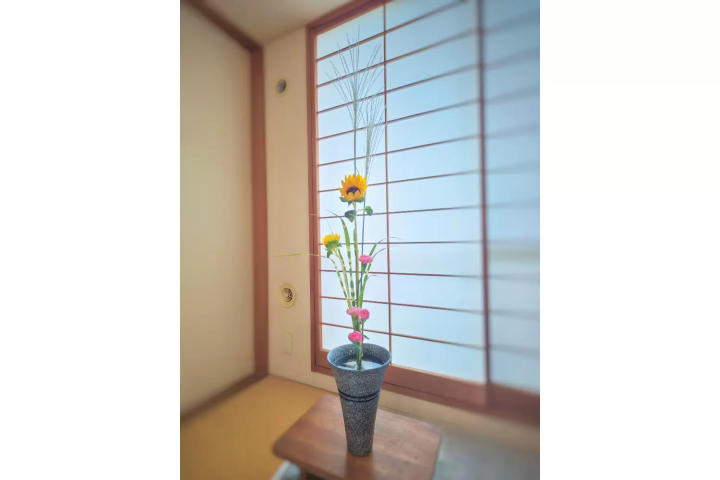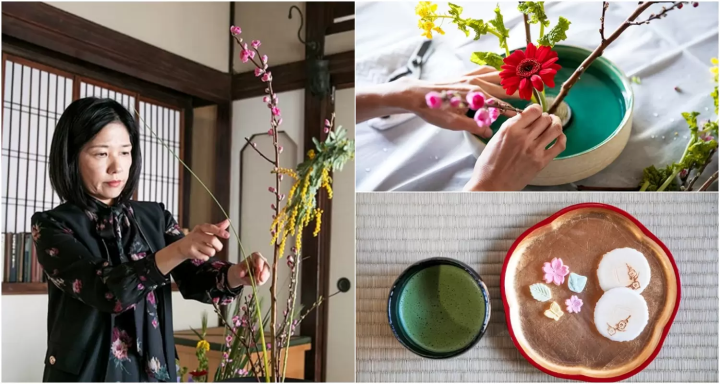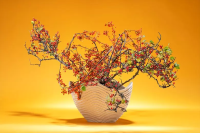Ikebana and Japanese Culture: An Introduction to the Way of Flowers

This is the first installment in a series of articles on ikebana, the Japanese art of flower arrangement. This time, we discuss the role of ikebana in Japanese culture as a personality-shaping endeavor that enhances one's awareness of the seasons and the natural environment.
Ikebana in Japanese Culture
Reading about Japan, you may have heard about ikebana, the Japanese art of flower arrangement. There are plenty of opportunities to experience it during a trip to Japan, either through ikebana workshops or exhibitions that are regularly held in major cities.
More than an elegant pastime, ikebana is a way of connecting to nature and the seasons. For those who seek a deeper understanding of Japanese culture, it offers insights into how nature and the seasons are perceived in Japan.
This is the first installment of a series of articles on ikebana, which will feature information on the origins of this art, major schools, the main styles of ikebana, specialty shops where you can find tools and vessels, and ikebana exhibitions and workshops.
Ikebana and Japanese Culture, Part 1
1. Author Introduction
2. The Difference Between Ikebana and Flower Arrangement
3. The Personality-Shaping Features of Ikebana
4. Today's Ikebana
5. Experience Ikebana in Tokyo
Author Introduction

Ikebana work by the author displayed at the Ikenobo School Spring Ikebana Exhibition in Tokyo, May 2023
I'm Ramona, English content editor at MATCHA, and I've been practicing Ikenobo school ikebana since June 2012. I started soon after arriving in Japan as a foreign student.
My major was Japanese literature, in which flowers and trees often appear as symbols and motifs. In Japanese poems and stories, flowers express emotions and aspects of life, suggesting that humans and the natural environment are interconnected.
What has kept me motivated to continue taking ikebana lessons over the years is that I discover something new about Japanese culture each time. Twelve years on, the feeling of wonder shows no signs of faltering.
I currently hold the Professor - Level 3 certification, which allows me to teach basic courses and have my arrangements displayed at exhibitions. Ikebana is already an important part of my life and I plan to continue practicing it - and maybe even opening my own ikebana class someday.
Ikebana and Flower Arrangement: The Difference Between Them
Ikebana is often defined as a type of flower arrangement that was born and developed in Japan.
However, ikebana differs from other floral arts in that flowers are the subject when creating an arrangement. The flowers serve as the main characters, rather than merely objects to be manipulated according to human will.

When you work on an ikebana arrangement, the first thing you do is pick up each flower or branch and observe its features. Each flower has a "personality," which is crucial for determining the role it will play in the arrangement.
Is it suitable for the lead role? Or would it serve better in a supporting role, helping the main character stand out? These are the decisions you make by carefully examining the flowers.
Moreover, in ikebana, the flowers are arranged in such a way that they retain their distinct characteristics. For instance, a rose will still look like a rose in the arrangement. Tearing off its petals and using them separately is not acceptable in ikebana.
The Personality-Shaping Features of Kado, the Way of Flowers

Ikebana exhibition at the Tokyo Metropolitan Art Musem, March 2021
A strange thing happens when you look at a flower or branch and "listen" to it, trying to grasp its features. The center of your attention shifts from yourself to the flower.
You become an "outside presence," helping the flowers look their best in the arrangement, much like an assistant preparing a star performer for the stage.
Remember that you're dealing with living flowers and branches that have already been cut. Life wilts away from them in a matter of hours or days.
Ikebana gives the flowers a chance to shine in a beautiful work of art before they fade away. Some authors attribute this perspective to Buddhist philosophy, but I believe it ties to the basic human instinct of caring for life—rooted in mercy and empathy. Someone who cares about the life of a flower or branch is likely to care about the lives of other living creatures as well.
There are various ways and techniques to prolong the life of flowers, but an arrangement containing flowers will last at most three days. An arrangement with tree branches can last a few weeks if properly cared for.
The word ikebana itself comes from 生ける (ikeru), which means "make live," and shares roots with ikiru, meaning "to live," and the Japanese word for "life."
In other words, flowers become the center of the universe when you're creating an ikebana work. Everything else, including your own consciousness, revolves around the flowers for an hour or two while you're working on the arrangement.
By engaging in this practice regularly, you become less self-centered. You develop an awareness of the natural environment, the seasons, and the unique features of each plant. Before you know it, you start noticing the needs of the people around you more easily.
This is why ikebana has been regarded as a personality-shaping endeavor, much like the tea ceremony or martial arts.
It served as a way to educate children about the natural environment before formal schooling existed. It has also been a method for people to cultivate skills essential for social life.
Kado, "the way of flowers," written as 華道 in Japanese, is another term for ikebana as a pursuit—an activity in which flowers help you acquire a new perspective on the world.
It may seem like you are creating the arrangement, but remember that the flowers are the subject. Listen to what they have to say; they will guide you in bringing beauty into the world. In ikebana, you are the flowers' disciple.
Today's Ikebana

Shoka-style ikebana with sunflowers, susuki (silver grass), and pink carnations
September marks the transition from summer to autumn in Japan, so this month's ikebana works combine elements from both seasons. In this arrangement, I featured sunflowers to evoke summer and silver grass, a beloved September motif in Japan. Silver grass is also used in the decorations for the Harvest Moon Festival (Tsukimi).
In the next installment, I will briefly outline the early history of ikebana.
Experience Ikebana in Tokyo

Pictures courtesy of Wabunka
To experience ikebana in Tokyo, join this workshop led by Professor Fuse from the Ikenobo School. You will learn the fundamentals of handling flowers in ikebana, as well as insights into the Japanese worldview regarding nature and plants.
After creating your own ikebana arrangement with seasonal flowers, you will enjoy matcha tea prepared by Fuse-sensei in an authentic tea ceremony style, accompanied by seasonal Japanese sweets.
The workshop takes place in Nezu, near Tokyo’s Ueno district—a peaceful area rich in historical buildings and traditional charm.
FAQ
What is ikebana?
Ikebana is the traditional Japanese art of flower arrangement. It emphasizes harmony, balance, and simplicity, often using minimal materials to create aesthetically pleasing compositions. Unlike Western floral arrangements, which tend to be more prolific and symmetrical, ikebana focuses on line, balance, and space.
Ikebana arrangements can reflect the changing seasons and often incorporate natural elements such as branches, leaves, and even stones. There are various styles and schools of ikebana, each with its own principles and techniques, making it both a creative and meditative practice.
Why is ikebana important to Japanese culture?
Ikebana, the traditional Japanese art of flower arrangement, is significant to Japanese culture for several reasons. It serves as a form of artistic expression, allowing creativity and emotional conveyance through natural materials. The practice embodies key aesthetic principles, such as simplicity and asymmetry. Rooted in history, ikebana links past practices to contemporary art, fostering cultural heritage. It is also seen as a meditative practice that promotes mindfulness and a deep connection to nature. Additionally, ikebana fosters community through classes and exhibitions, and its global recognition helps promote understanding of Japanese culture beyond its borders.
What is the ikebana philosophy?
The philosophy of ikebana is centered on key concepts that reflect Japanese aesthetics. It emphasizes harmony with nature, encouraging respect for the natural world and its seasons. Simplicity is crucial, with minimal elements used to create impactful designs. Asymmetry is preferred over symmetry, promoting balance through varied heights and lines that mimic nature's irregularities. The use of negative space enhances visual impact and conveys movement. Ikebana acknowledges transience, highlighting the fleeting nature of beauty and encouraging appreciation for each moment. Additionally, the practice serves as a form of meditation, fostering self-reflection and inner peace. Together, these principles cultivate a deep connection to life and nature, celebrating beauty in its many forms.
Read also
Ramona, English content editor at MATCHA since 2016, has been practicing ikebana flower arrangement (Ikenobo School) and tea ceremony (Omote Senke) since 2012. She arrived in Japan in 2012 as a graduate student with a focus on Japanese literature and performing arts. As a travel editor and writer, Ramona has visited and documented 40 of Japan's prefectures with a focus on art, history, traditional Japanese crafts, and performing arts.































![[30 minutes by train from Nagoya] Feature Articles cherry blossom viewing spots in the tourist destination of Tokoname](https://resources.matcha-jp.com/resize/720x2000/2026/01/08-255150.webp)



![[2026] Top 5 Strawberry Picking Spots in Tokushima, Naruto| Farms and Access Guide for January to May](https://resources.matcha-jp.com/resize/720x2000/2025/03/06-227165.webp)